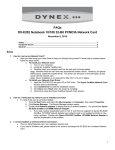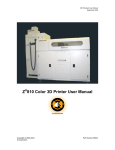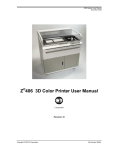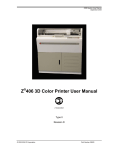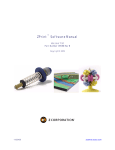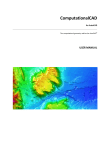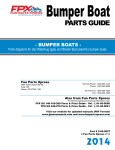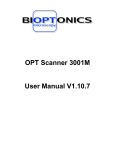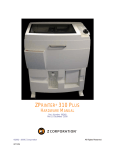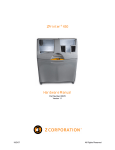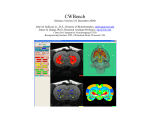Download Z Corporation Z 406 Owner`s manual
Transcript
Z Corp. System Software April 2002 Z Corporation System Software Version 5.2.55 © 2002 Z Corporation TABLE OF CONTENTS 1 OVERVIEW..............................................................................................................................3 1.1 COMPUTER SYSTEM REQUIREMENTS................................................................................. 3 1.1.1 ZTM400 System ...................................................................................................... 3 1.1.2 Z406 System ......................................................................................................... 4 1.1.3 Z810 System ......................................................................................................... 4 1.2 INSTALLING THE Z CORP. SYSTEM SOFTWARE ................................................................... 5 1.3 SETTING USER DEFAULT PRINTER AND POWDER ............................................................... 6 1.4 SETTING USER PREFERENCES .......................................................................................... 7 1.5 Z CORP. SYSTEM SOFTWARE MAIN WINDOW .................................................................... 8 1.6 THE SYSTEM SOFTWARE TOOLBAR ................................................................................... 9 2 SETTING UP THE BUILD......................................................................................................10 2.1 OPENING A FILE ............................................................................................................. 10 2.2 NAVIGATING THROUGH THE BUILD AREA .......................................................................... 12 2.2.1 Viewing Cross Sections of the Build.................................................................... 12 2.3 TRANSFORMING THE PART .............................................................................................. 13 2.3.1 Part Selection ...................................................................................................... 13 2.3.2 Copy and Paste ................................................................................................... 14 2.3.3 Bleed Compensation ........................................................................................... 14 2.3.4 Translate Parts .................................................................................................... 16 2.3.5 Rotate Parts......................................................................................................... 16 2.3.6 Mirror Parts .......................................................................................................... 17 2.3.7 Scale Parts .......................................................................................................... 17 2.3.8 Justify Parts ......................................................................................................... 17 2.3.9 Color Parts........................................................................................................... 19 2.3.10 Anisotropic Scaling .............................................................................................. 19 2.4 OBTAINING INFORMATION ABOUT THE BUILD .................................................................... 20 2.4.1 Print Time Estimator ............................................................................................ 20 2.4.2 Part Statistics....................................................................................................... 20 2.4.3 Collision Detection............................................................................................... 20 2.5 3D PRINT SETUP ............................................................................................................ 21 2.5.1 Changing Powder Parameters ............................................................................ 22 2.6 SAVING YOUR WORK ...................................................................................................... 24 2.7 EXPORTING PLY ............................................................................................................. 24 3 COMMUNICATING WITH THE 3D PRINTER ......................................................................25 3.1 3.2 3.3 3.4 3.5 3.6 4 SERVICE MENU .............................................................................................................. 25 Z406 SYSTEM SERVICE MENU ........................................................................................ 26 Z810 SYSTEM SERVICE MENU ........................................................................................ 27 PRINTER STATUS............................................................................................................ 28 PRINT TIME DELAYER ..................................................................................................... 29 LOGGING FILES .............................................................................................................. 30 INDEX ....................................................................................................................................31 [email protected] 2 Z Corp. System Software 1 OVERVIEW The Z Corporation (Z Corp.) System Software is a Windows-based program that allows the user to manipulate file data to print on any Z Corp. 3D Printer. This manual is separated into three sections – overview, setting up the build, and communicating with your 3D Printer. 1.1 COMPUTER SYSTEM REQUIREMENTS 1.1.1 ZTM400 SYSTEM Minimum System Requirements • Microsoft Windows* 95™ or 98™ operating system • Personal computer using a 300 MHz Pentium chip or higher • 64 MB of RAM • 16-bit color (or better) • 800 x 600 pixels (or better) • 2MB graphics card (or better) PLEASE NOTE: Even if your system has the capability to run the System Software, it may not be properly configured. To ensure that your computer is ready, select on the desktop where there is not an icon with the right mouse button. Select Properties, and then select Settings. Make sure that 16-bit color or higher is selected. Recommended System • Microsoft Windows1 NT 4.0, or Windows 2000 Professional operating system • Personal computer using a 400 MHz Pentium II chip or higher • 128 MB of RAM • 16-bit color (or better) • 1024 X 768 pixels (or better) • Graphics card accelerated for OpenGL • Virtual Memory of 500 MB * Microsoft Windows is a trademark of Microsoft Corporation www.zcorp-users.com 3 1.1.2 Z406 SYSTEM Minimum System Requirements • Microsoft Windows NT 4.0, or Windows 2000 Professional operating system • Personal computer using a 300 MHz Pentium chip or higher • 256 MB of RAM • 16-bit color • 800 x 600 pixels • 4MB graphics card Recommended System 1.1.3 PLEASE NOTE: Even if your computer system has the capability to run the System Software, it may not be properly configured. To ensure that your computer is ready, select on the desktop where there is not an icon with the right mouse button. Select Properties, and then select Settings. Make sure that 16bit color or higher is selected. • Microsoft Windows NT 4.0 or Windows 2000 Professional operating system • Personal computer using a 850 MHz Pentium III chip, AMD Athlon, or better • 512 MB of RAM or more • True Color Graphics • 1024 X 768 pixels, or better • Graphics card accelerated for OpenGL • Virtual Memory of 1 GB Z810 SYSTEM Minimum System Requirements • Microsoft Windows NT 4.0, or Windows 2000 Professional operating system • Personal computer using a 1 GHz Pentium chip or higher • 1 GB of RAM • True Color Graphics • 1024 X 768 pixels, or better • Graphics card accelerated for OpenGL • Virtual Memory of 1 GB PLEASE NOTE: Even if your computer system has the capability to run the System Software, it may not be properly configured. To ensure that your computer is ready, select on the desktop where there is not an icon with the right mouse button. Select Properties, and then select Settings. Make sure that 16bit color or higher is selected. Recommended System The system requirements may involve a higher performance computer based on file size and type. For more information, please contact the Z Corporation Service Department at (781)852-5050, (877)88-ZCORP, or via email at [email protected]. [email protected] 4 Z Corp. System Software 1.2 INSTALLING THE Z CORP. SYSTEM SOFTWARE 1. Close all open applications on your computer, make sure Windows NT 4.0, or 2000 Professional Operating System is running and insert the Z Corp. System Software CD into your CD-ROM drive. 2. If the installer does not start automatically, double-click on your CD-ROM drive and then double-click on the ‘Setup.exe’ icon. This will start the setup sequence. 3. Read the licensing agreement carefully. 4. Select destination directory. The program will prompt you for a selection and will offer C:\Program Files\ZCorp System Software as the default directory. Choose your installation preference: typical (recommended), compact or custom. Once you have made your selection, it may take several minutes to install the program. When complete, you will be returned to your main window. If you encounter any problems during installation, please contact the Z Corporation Service Department at (781) 852-5050, (877) 88-ZCORP, or via email at [email protected] WARNING: To avoid problems that may occur during printing, ensure that all screen savers and your power management software are turned off on the computer driving the Z Corp 3D Printer. Most screen savers and power management software can be turned off in the main Windows screen settings. For additional instructions on how to disable your hardware and software power management, please consult your computer hardware owner’s manual. www.zcorp-users.com 5 1.3 SETTING USER DEFAULT PRINTER AND POWDER Before proceeding, we recommend setting up your default Printer and Powder. To do this, open up the ‘3D Print Setup’ dialog box under the File menu and follow the instructions below. 1) Select the Printer that you will be using by choosing ‘Select Printer’. You may choose any printer that is connected by serial port or network. (The network option is only available on the Z810 3D Printer.) If the Printer is busy or offline, the option to select this printer will not be available. 2) ‘Save Printer as Default’ enables you to save the chosen printer so that the software remembers to use the settings for this printer when the software is reopened. 3) Choose ‘Powder Type’ by clicking on the list box. Save this powder type as the default powder so that the printer will remember to use this powder for every print job unless manually changed. If you would like to use a powder that is not the default, you may manually change powder type by choosing from the ‘Powder’ list box. [email protected] 6 Z Corp. System Software 1.4 SETTING USER PREFERENCES You may change the default settings for several software features by selecting ‘Preferences’ from the Edit menu. • Units. You may choose to have the measurements for your parts displayed in either inches or millimeters. This will change the way that part dimensions and layer thickness are displayed, but it will not change the underlying dimensions on the part. You will still need to choose the proper units when opening or importing a new file. • Save slice data in ZBD files. When a build file (ZBD) is saved, the slice information is discarded and the part is resliced when the file is reopened. This is generally the best strategy for saving files; the file size is significantly smaller, and because it is smaller, it will take less time to reopen. However, once the file is opened, you will have to wait while the file reslices. If you wish to save slice data, check this box. • Orient imported parts for the fastest print times. When this box is checked, parts are always rotated so that the smallest dimension of the part occurs in the Z direction. Since build times are largely determined by the height of the part, this arrangement produces the fastest build times. But if you are importing several parts that need to be placed in a predetermined arrangement to each other, you can uncheck this box and prevent the software from automatically rotating the part. • Offer fast rendering for parts larger than 100,000 facets. Large parts with many facets can be slow to draw on the screen. It is often convenient to draw the parts using "Fast Rendering," which can be selected from the View menu. When a file is larger than a certain threshold, before drawing the part for the first time, the software will ask you if you prefer to use fast rendering. You can still choose to use photo-realistic rendering. If you have a very fast video display you may want to set the threshold higher, or even uncheck the box. If your computer is slow to draw and refresh the screen, you can set the threshold lower. Recommended threshold is 100,000 facets. www.zcorp-users.com 7 • Warn if entity is outside the build box. If your part is outside the build area, the boundary surrounding the part will be red. The software will also show a dialog box reminding you that your part is outside the printable area. You may choose not to receive the warning by turning off this feature. 1.5 Z CORP. SYSTEM SOFTWARE MAIN WINDOW Task Bar Top View Cross-Sectional View Front View Layer Count Height from base of Build Box Figure 1: The Main System Software Window The System Software provides three views of the build in the Main Window. • • • The top view presents the view of the build in the x-y plane from the top. The front view presents the view of the build in the x-z plane from the front of the build area. The horizontal yellow line marks the cross-section being displayed in the crosssectional view. The cross-sectional view displays the layers that the 3D Printer will print. The window views can be resized for user convenience. To resize a window, place the curser over the border between views, left-click on the border and drag to create your preferred window size. [email protected] 8 Z Corp. System Software 1.6 THE SYSTEM SOFTWARE TOOLBAR Open 3D Print Save Mirror Translate Cut Import New Rotate Copy 3D Print Setup Paste Scale Ten Layers Down One Layer Up Justify Ten Layers Up Select ion List Help One Layer Down Figure 2:The System Software Toolbar www.zcorp-users.com 9 2 SETTING UP THE BUILD 2.1 OPENING A FILE When you initially open the Z Corp. System Software, you will be presented with an Open dialog box. Select the file you wish to open. You may open zbd, stl, bld, ply, zcp, sfx, zec, or wrl files. Keep in mind the available print areas of the printer. Here are the following print areas: Z400 3D Printer - 8 x 10 x 8 inches (200 x 250 x 200 mm.) Z406 3D Printer - 8 x 10 x 8 inches (200 x 250 x 200 mm.) Z810 3D Printer – 20 x 24 x 16 inches (500 x 600 x 400 mm.) File Formats: zbd files are build files created by the Z Corp. System Software. stl files are monochrome 3D model files exported by several 3D CAD packages. zcp files are Z Corporation color files. ply files are color 3D model files exported by several 3D CAD packages. zec files are files created by the previous version of the Z402C System Software. bld files are build files created by the previous version of the Z402 System Software. [email protected] sfx files are color 3D model files exported by SolidView/Pro. wrl (also known as VRML) files are color files that are exported by many 3D CAD packages. 10 Z Corp. System Software When importing WRL (VRML) files you will be asked to input mesh resolution and texture threshold settings. Mesh resolution is the number of facets in a graphic primitive. A graphic primitive is composed of elements that are made up of cones, cylinders, and spheres as opposed to triangles. The default is set at ‘40’. Setting the number higher will increase the number of facets making your file larger; lowering this number will reduce the number of facets. Texture threshold pertains to scan data, FEA files and other files that contain texture maps. A value of ‘0’ will render every color. Thus, producing a large file. Increasing the number will produce coarser rendering. After the software has read the file, it will ask you to choose units. A dialog box will prompt you to choose units (inches, millimeters, centimeters, or meters.) The System Software will select as a default the largest unit that will fit the part into the print area. VRML files will always import in meters. You may also select the powder type. After you select the units, the System Software will place the object into the build area in the way that will minimize print time if you have chosen this option under the ‘Preferences’ menu. You may import multiple files into a single build—each subsequent file will be placed within the build area such that the objects will not overlap. To insert additional files, choose ‘Import’ under the File menu. You may import stl, ply, zcp, sfx, or wrl files. If the model has many facets, the fast rendering option will be offered if you have selected this option under the ‘Preferences’ menu. This may also be selected later under the ‘View’ menu. www.zcorp-users.com 11 If the imported file is rendered dark and the slices are not visible in the cross sectional view, the back facets of the file are showing. The part will not print properly in this orientation. To correct the file, select part and invert all normals. This feature is found under the ‘Edit’ menu. Normals Inverted Normals Corrected 2.2 NAVIGATING THROUGH THE BUILD AREA 2.2.1 VIEWING CROSS SECTIONS OF THE BUILD The System Software offers you several ways to view cross sections: To do this: Menu Command Toolbar Keyboard Shortcut Move up one level Select ‘One Layer Up’ from the View menu ‘a’ Move down one level Select ‘One Layer Down’ from the View menu ‘z’ Move up ten levels Select ‘Ten Layers Up’ from the View menu Shift ‘a’ Move down ten levels Select ‘Ten Layers Down’ from the View menu Shift ‘z’ TECHNICAL TIPS…. When setting up your build area with multiple parts, place larger, bulkier parts towards the bottom of the build box. [email protected] 12 Z Corp. System Software 2.3 TRANSFORMING THE PART 2.3.1 PART SELECTION First select your part(s). To select parts within the build area click on the part with the left mouse button. An yellow rectangle will appear around the part. To select multiple parts, hold down the Shift key and select the parts you wish to modify. To de-select a single part, hold down the Shift key and click on the image of the part. To de-select all parts, click on an open area. You may also select parts by using the ‘Entity Selection’ option under the Edit menu. There is also an icon on the toolbar for this function. Click on the part you wish to select. To choose multiple parts, hold the Control (CTRL) key and click on the additional parts. • Once imported or opened, parts can be copied, translated, rotated, scaled, mirrored, justified, and colored within the print area. These options are available under the Edit and Transform menus. They are also available through a pop-up dialog box when you right click on any part of the build box. • Choosing the ‘Undo’ option under the Edit menu will reverse the previous action made under the Transform menu. This means that any feature under the Transform menu can be reversed. The copy and color feature under the Edit menu cannot be reversed. Pop-Up Menu available when Right-Clicking on the mouse. www.zcorp-users.com 13 2.3.2 2.3.3 • You may make additional copies of your part by selecting the part, then choosing the ‘Copy’ option under the Edit menu or clicking Control (CTRL) C, and then paste the file into the build by choosing the paste option under the Edit menu or pressing Control (CTRL) V. The software will allow for copying and pasting between different builds. • Any part copied is kept on the clipboard until the clipboard is emptied. If you have copied and stored a large part or several parts on the clipboard, you may empty the clipboard by selecting the ‘Empty Clipboard’ option under the Edit menu. Emptying the clipboard will reduce the amount of memory used. • To delete any unwanted parts, select the part and choose the Delete option under the Edit menu or click on Delete on the keyboard. • Binder printed on powder will tend to spread slightly, causing surfaces of a part to migrate outward. To compensate for “bleeding,” it is necessary to perform bleed compensation on the part, to shave off a small amount of thickness from all surfaces. The Z Corp. System Software allows you to perform this function. Choose the ‘Bleed Compensation’ option under the Edit menu. COPY AND PASTE BLEED COMPENSATION • • • The dialog box will detail the printer and material type. To change printer or material type, go to the 3D Print Setup. For more information, see Section 1.3, Setting User Default Printer and Powder. The Z Corp. System Software provides recommended values for x-, y-, and z-axes. You may override these values by typing in new numbers. To return to recommended values, click ‘Reset’. PLEASE NOTE: The values will differ according to printer and material type. [email protected] 14 Z Corp. System Software • To enable bleed compensation before printing, click on the bleed compensation option, located in the Printing Options dialog box. PLEASE NOTE: The Bleed Compensation option will remain enabled until you disable it by unclicking the Bleed Compensation option. • The software allows you to transform the part individually or as a group. When transformed individually, the center of transformation is located in the middle of the part. When transformed as a group, the center of transformation is located in the middle of the group. • The group function is useful if you would like to keep a group of parts oriented relative to each other. Here is an illustration to help clarify the differences between individual and group transformations. In the picture to the left, there are two parts in the print area. If both parts are selected and the ‘Rotate’ option is chosen, the parts will rotate and re-orient themselves relative to their individual centers, as can be seen in the picture. www.zcorp-users.com 15 If both parts are selected, and the ‘Rotate Group’ option is chosen, the parts will rotate and reorient themselves relative to the center of the group as can be seen in the picture. 2.3.4 TRANSLATE PARTS • To translate or move your parts within the build area: Select parts within the print area, and move with the mouse. You may move the object more precisely by choosing ‘Translate’ from the Transform menu. 2.3.5 ROTATE PARTS • To rotate a part, select the part and choose ‘Rotate’ from the Transform menu. In the dialog box, specify the plane and degree of rotation. • To keep a group of parts in the same relative orientation, rotate as a group. Select the parts, and choose ‘Rotate Group’. • You may also rotate using ‘Rotate in Active View’. Determine the view you would like to rotate the part in (top view, or front view). Then choose the part in that view. The yellow box surrounding the part will be highlighted in a brighter yellow box in the view that you have chosen. Then choose one of the options under the ‘Rotate in Active View’ menu. [email protected] 16 Z Corp. System Software 2.3.6 MIRROR PARTS Original File • Mirroring a part or group of parts allows you to inverse the orientation of the part features in the x, y, or z axis. The software does this by placing a plane in the center of the part in the x, y, and z axis. When you choose to mirror a part in a certain axis, the software will invert the part within that axis. Copy and Mirrored Hand in the X-Axis • To mirror a part, select the part and select “Mirror” from the Transform menu. The software will not create a separate part. It will take the part selected and invert the orientation for this part. • You may also mirror a group of parts by selecting the parts, and choosing ‘Mirror Group’. 2.3.7 SCALE PARTS • To scale the part, select the part and choose ‘Scale’ from the Transform menu. In the dialog box, you are given several options. You may scale the object relative to the dimensions in the imported file and the units you initially selected by entering a percentage in the ‘Relative’ box. Remember to limit your selection to the maximum limits of the build area. • You may also scale a group of parts by selecting the parts, and choosing ‘Scale Group’. Only the relative option is available when scaling a group of parts. 2.3.8 JUSTIFY PARTS • To justify the part, select the part and choose ‘Justify’ from the Transform menu. You may justify the part to the center, left, right, front, back or bottom of the build box. Justifying the part lets the software move the part to the edge of the print area optimizing your build area. • You may also choose to justify a group of parts. www.zcorp-users.com 17 PLEASE NOTE: In the process of changing the location or orientation of a part, you may find that parts overlap in the build box or exceed the boundaries of the build box. If parts exceed the boundaries of the build box, the System Software will alert you with an error message and the part in question will be outlined in red unless this feature has been disabled under Preferences. To fix the problem, select the part and either move it within the build box or use the ‘Justify’ feature to bring the part completely within the build box. You will need to rescale your part if it does not fit into the build box after justification. If parts overlap with each other in the build box, you will NOT receive an error message unless you choose to run the ‘Collision Detection’ feature under the View menu. The feature will take a few minutes to process the build. A dialog box will appear when the software detects a part overlap. It will let you know if there was a collision and where the collision was detected. After fixing the part overlap, carefully inspect the build box by checking the layers of the build. Press the A or Z key to move through each layer. Then rerun the Collision Detection function. [email protected] 18 Z Corp. System Software 2.3.9 COLOR PARTS The color option is only available when the System Software is connected to a Z Corp. Color Printer – Z402C, Z406, or Z810 3D Printer. You may color your monochrome stl part. 1. Select the part. 2. Choose ‘Color’ option under the Edit menu. 3. Pick a color from the color pallet or choose to define a custom color. 4. Click ‘OK’. The part will be colored by an outer shell as with all Z Corp. color parts. PLEASE NOTE: Only monochrome files (STL) may be colored. If you select a color part, the software will remind you that the color feature is only available for monochrome files. 2.3.10 ANISOTROPIC SCALING • Anisotropic scaling factors may vary for different types of geometries and powders. The software allows you to set anisotropic scaling factors for the build or for a specific part. • To change anisotropic scaling factors to affect the entire build, change the powder parameters under 3D Print Setup. For more information, see the User Manual for your printer. PLEASE NOTE: Before changing anisotropic scaling factors for specific parts, make sure anisotropic scaling factors have been set for the entire build. www.zcorp-users.com • In some circumstances, you may need to change your scaling factors for an individual part. To change anisotropic scaling factors for a specified part, choose the part and select the ‘Anisotropic Scaling’ option under the Transform menu. Enter your custom anisotropic scaling factors for the x, y, and z axis. Click ‘OK’. These anisotropic scaling factors will only affect the selected part(s). 19 2.4 OBTAINING INFORMATION ABOUT THE BUILD The System Software allows you to estimate the time required to print your build in color and monochrome mode, the number of pixels the part will use and other statistics. 2.4.1 2.4.2 2.4.3 PRINT TIME ESTIMATOR • Select ‘Print Time Estimator’ from the File Menu. The System Software will return a dialog box with the estimated build time. For the Z400 Printer, only the monochrome build time will be available. • To calculate the surface area and volume of the build, select ‘Calculate Part Statistics’ from the View menu. • Collision detection will search for parts that are placed too close together or overlap. When parts are placed too close together, the sides of the parts may adhere to each other. It will take the software a few minutes to search through the layers. Once a collision has been detected, a dialog box will appear regarding which layer the collision was detected. PART STATISTICS COLLISION DETECTION PLEASE NOTE: Collision Detection will only report the first collision detected. Please make sure to check layers or run Collision Detection again after fixing the problem. [email protected] 20 Z Corp. System Software 2.5 3D PRINT SETUP The ‘3D Print Setup’ dialog box allows you to select a printer, choose a powder type, and change powder parameters. This dialog box is found under the ‘File’ menu. It is also located as an icon on your task bar. IT IS STRONGLY RECOMMENDED THAT THE 3D PRINT SETUP PARAMETERS BE CHECKED BEFORE PRINTING A BUILD. Information regarding setting up your printer and powder type as defaults can be found in Section 1.3, Setting User Default Printer and Powder. www.zcorp-users.com 21 2.5.1 CHANGING POWDER PARAMETERS The saturation settings for plaster-based powder are constant for all parts. Please refer to the Powder Fact Sheet for recommended saturation values. The saturation values for starch-based powders vary depending on the wall thickness of the part. The System Software will calculate and recommend a saturation value when using starch-based powders. The default saturation values suggested by the software for starch-based powder are designed to successfully print a majority of parts. You may, from time to time, choose to override these saturation levels. Please refer to the Powder Fact Sheet for recommended saturation ranges. Saturation and anisotropic scaling factors will differ depending on material system, printer type, and color/monochrome mode. In general, bulkier parts will print more successfully in starch with a lower setting and delicate parts will print better with a higher setting. To change Powder Parameters for the chosen powder: 1) Click on the ‘Override…’ button. 2) Choose the unit of measure for layer thickness. 3) Choose a given layer thickness or to put in your own layer thickness, choose ‘Other’. PLEASE NOTE: Your custom layer thickness will be saved as long as you continue to use this layer thickness. Once you choose to use a standard layer thickness, the custom layer thickness will no longer be the default. The ‘Other’ option will reappear. 4) Shell Saturation values may be changed based on three factors – Binder/Volume Ratio (%), Saturation Level (%), and Saturation. When changing any value corresponding to Shell Saturation, the relative Core Saturation will also be changed. The saturation values displayed in the dialog box will be a percentage of a recommended saturation value. To set the saturation values to 100% of the recommended values, click on ‘Reset Factory Settings’. 5) Input the core saturation manually if needed. [email protected] 22 Z Corp. System Software PLEASE NOTE: Z Corporation provides recommendations for shell and core saturation for powder types. This can be found on the Powder Fact Sheet provided with your case of powder. You may choose to increase saturation values for higher strength or decrease saturation values due to difficulties with depowdering. PLEASE NOTE: If printing with starch-based powders - When pressing “3D Print”, a warning will appear if you do not check the 3D Print Setup dialog box before printing. It will let you know how the saturation is currently set before printing. If you choose to override the saturation values, click ‘No’ and edit the settings as described above. If you would like to continue printing with the saturation values given, click on ‘Yes’. 6) Default values are defined in terms of percentage. The recommended saturation values will always be at 100%. You may choose to set a default percentage value for saturation values and save these as default. This will be applied when you press ‘Use Default’. For example, if you would like to use 90% of the recommended shell saturation value for every build, choose to override the current settings and type in the desired value. Click ‘OK’. Then select ‘Save as Default’. This will save your shell saturation percentage value as default. When setting up a new build, click on ‘Use Default’. The percentage value saved will be used. In this example, the shell saturation value would be set at 90% of the default. Input anisotropic scaling factors for the chosen powder. These values may then be saved as default values in the ‘3D Print Setup’ dialog box. This scaling will affect all parts in the build. You may choose to assign anisotropic scaling factors for each model by using the ‘Anisotropic Scaling’ option under the Transform menu. PLEASE NOTE: The build anisotropic scaling factors will override any factors set for each model. Thus, it is recommended that the build anisotropic scaling factors be set first. Anisotropic scaling operates as a simple multiplier. The shrinkage or expansion you experience may differ from the norm because of humidity and temperature variations between operating environments. The anisotropic scaling factors allow the printer to compensate for these differences. PLEASE NOTE: When anisotropic scaling factors are applied to a build, the physical part will increase or decrease in size. The part rendered on the software will change in appearance with the anisotropic change but the dimensional values will remain the same. You may need to rescale or justify the part after changing anisotropic scaling factors. www.zcorp-users.com 23 2.6 SAVING YOUR WORK After you have imported the files, oriented the parts and set up your build to print, save your work by selecting ‘Save As’ from the File menu. After you choose a name for your build, select ‘Save’ and your work will be saved as a *.zbd file. A build file contains all of the modifications that you have made to the parts and the settings you have selected for the build. If you reopen and work on an existing build file, you can save your changes to the *.zbd file by either selecting ‘Save’ from the File menu or choosing the save icon from the tool bar. 2.7 EXPORTING PLY The System Software allows you to export your model from the build if needed so that you may alter your part. To export a part, choose the part. Then choose the ‘Export PLY’ option under the File menu. [email protected] 24 Z Corp. System Software 3 COMMUNICATING WITH THE 3D PRINTER The System Software communicates with the Printer in several ways. It communicates with the Printer during routine Service procedures, and allows the user to receive Printer Status. 3.1 SERVICE MENU The System Software allows you to draw information from the Z Corporation 3D Printer and activate some printer functions. The basic Service menu is available when any Z Corp. Printer is communicating with the software. For more information about how the Service functions work, see the User Manual. • Get Piston Levels. (Shortcut Key: F1) To check the available powder in the Feed Piston and the remaining room in the Build Box, Select ‘Get Piston Levels’. This option also communicates firmware version. • Squirt Squeegee. (Shortcut Key: F2) This feature allows you to rinse the squeegees in the Service Station or test the alignment of the Squeegee Squirters. This feature applies to the Z406 and Z810 Printers. • Service Print Head. (Shortcut Key: F3) This feature allows you to service the print head if it is not printing well. • Toggle Roller on/off. (Shortcut Key: F4) This allows you to activate the roller independently for easy cleaning. • Toggle Vacuum hi/low. (Shortcut Key: F5) This feature applies to the Z402 and Z402C 3D Printers. • Change Print Head. This feature allows you to change the print heads, as described in detail in the User Manual. • Flush Binder. This feature allows you to cycle fluid through the plumbing system, which is useful in changing the binder color or binder type, as described in detail in the User Manual. • Report Capabilities. This feature allows you to view the capabilities of the Z Corporation Printer connected to your computer. It reports the build size, and print modes. • Report Print Head Usage. This feature calculates the accumulated pixel usage for all print heads. • Stripe Test. This feature allows you to test the printing status of your print heads. This feature is available on the Z406 and Z810 Printers. • Upload New Firmware and Upload New Printer Configuration. These features allow you to upgrade the firmware that is in your 3D Printer. The Service Department will provide you with required upgrades and instructions. Use this option only under the guidance of the Service Department. www.zcorp-users.com 25 In addition to the basic Service menu, each of the Z406 and Z810 Printers have specific service menus. 3.2 Z406 SYSTEM SERVICE MENU When connected to a Z406 3D Printer, the 406Service menu will be an option. • Purge Print Heads. Use this feature after changing the print heads and printing the alignment test. This runs binder through the print head, replacing the HP ink with binder as described in the User Manual. • Alignment. This feature is used to align the print heads after changing them as described in detail in the User Manual. • Color Alignment. This feature is used to align the color print heads after the standard alignment as described in detail in the User Manual. • Change Binder Supply. This feature allows you to change between color and monochrome binder systems. • Unpark. This feature allows you to unpark the carriage to allow for cleaning the Service Station. • Bleed Air. This function allows you to remove air from the fluid system. This feature is only used when air has entered your fluid system due to binder shortage when printing. Use this feature only with the guidance of the Z Corporation Service Department or authorized Z Corporation service provider. • Print Head Report. This feature allows you to view the number of pixels printed, temperature levels, and flow rates of the current print heads. • View Log. This feature allows you to view the printer log, which records historical printer performance. • Edit .INI File, Send File and Receive File. These features are used during diagnosis. They should be used under the instruction of the Z Corporation Service Department or authorized Service representative. [email protected] 26 Z Corp. System Software 3.3 Z810 SYSTEM SERVICE MENU When connected to a Z810 3D Printer, the 810Service menu will be an option. • Purge Print Heads. Use this feature after changing the print heads and printing the alignment test. This runs binder through the print head, replacing the HP ink with binder as described in the User Manual. • Alignment. This feature is used to align the print heads after changing them as described in detail in the User Manual. • Change Binder Supply. This feature allows you to change between color and monochrome binder systems. • Unpark. This feature allows you to unpark the carriage to allow for cleaning the Service Station. • Bleed Air. This function allows you to remove air from the fluid system. This feature is only used when air has entered your fluid system due to binder shortage when printing. Use this feature only with the guidance of the Z Corporation Service Department or authorized Z Corporation service provider. • Print Head Report. This feature allows you to view the number of pixels printed, temperature levels, and flow rates of the current print heads. • View Log. This feature allows you to view the printer log, which records historical printer performance. • Edit .INI File, Send File and Receive File. These features are used during diagnosis. They should be used under the instruction of the Z Corporation Service Department or authorized Service representative. • Fill Bed. Prepares the build to print by filling the bed with powder. It is the equivalent of pushing the ‘Fill Bed’ option on the printer control panel. • Empty Overflow. This feature allows you to empty the overflow bin before each build. • Spit on Deck. This feature allows you to test the print quality of your print heads. This feature is used after changing print heads. But can also be used when your print heads have reached a high pixel count. www.zcorp-users.com 27 3.4 PRINTER STATUS When the Printer is getting ready to print, it will conduct a system status check of the Printer. For example, with the Z406 and the Z810 Printers, if you have a color model in the build but are in monochrome mode, the System Software will remind you that you are in monochrome mode and ask if you would like to continue printing the part. On all Z Corp. Printers, the System Software will warn you if you do not have enough materials to print your model. During printing, the System Software will update you on the status of your print job. [email protected] 28 Z Corp. System Software 3.5 PRINT TIME DELAYER The System Software also allows you to print your build at a later time. In instances where the set up time in the build area is specific (as in the case of starch builds), you may choose to use the print time delayer option in order to have the part finish at a certain time. For instance, if you would like to print a five-hour starch part to finish at 8:00 AM, you would use the print time delayer to begin printing the part beginning at 3:00 AM. Using the print time delayer option prevents parts from sitting in the build area for too long. This option can be enabled before printing in the 3D Print Options dialog box. You will then be asked to input how many hours and/or minutes to delay your build. You may also choose to use the arrows to increase or decrease values. The estimated finish time will change as you input values for the hours and minutes. www.zcorp-users.com 29 3.6 LOGGING FILES In addition to communicating with the Printer, the System Software also records print information from the Printer. When the option to log files is checked off at the start of the build, the System Software will log information regarding each build. The log files can be found in the directory “C:\ZCorp Printer Records\Print Logs”. They are tab-delimited files for easy import into a spreadsheet. When the print heads are changed, the line ” Print head changed!” is inserted. If this file becomes too large, either delete it or rename it; the software will automatically start a new one. There is also an html file letting you know the status of your build. This file can be accessed through the network by sharing this Print Logs folder. To share this folder, right click on the folder, select properties and select the ‘Sharing’ tab. Choose to share the folder. Below is a description of the data found in the log file. Build Date: Time: Job Pixels: The desktop computer’s date when the build was started. Time to complete printing in minutes. Total number of pixels fired during the job (sum of all print heads). Note: pixels are not logged for print head purging between jobs. Fed: Approximately how much binder was fed during the job, in milliliters. Prime Does not apply to the Z406 or Z810 Systems, only the Z400, Z402, and Z402C Systems. Dsize Does not apply to the Z406 or Z810 Systems, only the Z400, Z402, and Z402C Systems. DSDEV Does not apply to the Z406 or Z810 Systems, only the Z400, Z402, and Z402C Systems. Error If the job was terminated with an error code, it will be recorded here. Max The maximum head temperature during the build. Min The minimum head temperature during the build Pre Does not apply to the Z406 or Z810 Systems, only the Z400, Z402, and Z402C Systems. Vol Part volume Area Total printed area Shell Shell saturation Core Core saturation Thickness Layer thickness Name File name for the job Version Software Version Powder Type Powder System Color Mode Color or Monochrome Mode BleedComp Bleed Compensation On or Off Estimated Time Estimated print time for build Estimated Pixels Estimated pixel usage for build Head Report The accumulated number of pixels printed per print head. [email protected] 30 Z Corp. System Software 4 INDEX 3 3D Print Setup 22 A Anisotropic Scaling For Specified Part Anisotropic Scaling Values 20 24 B BLD Build Files Bleed Compensation 10 14 C Changing Powder Parameters Collision Detection Color Computer System Requirements Z400 System Z406 System Z810 System Copy Empty Clipboard From Different Build Cross-Sectional View Main Window Viewing Layers STL Files VRML Files WRL Files ZBD Files ZCP Files ZEC Files Fill Bed 10 10 10 10 10 10 28 I Importing a File Installation 11 5 J Justify 23 19, 21 19 3 3 3 4 14 14 14 8 12 18 L Layer Thickness Logging Files 23 31 M Main Window Cross-Sectional View Front View Resize Top View Mirror Group 8 8 8 8 8 17 D Delete N 14 Normals Invert All E Empty Clipboard Empty Overflow Entity Selection Export PLY 14 28 13 25 12 O Open Files Orient for Faster Print Time 10 7 F Fast Rendering Preferences Logging 10 File Formats BLD Files PLY Files SFX Files www.zcorp-users.com P 7 31 10 10 10 10 Part Statistics Paste PLY Files Pop-Up Menu Preferences Fast Rendering Orient for Faster Print Time Save Slice Data 21 14 10 13 7 7 7 31 Units Warn if Part is Outside of Build Box Print Time Delayer Print Time Estimator Printer Status 7 8 30 21 29 R Rotate Group In Active View 17 17 17 T Time Estimator Toolbar Transform Individual vs. Group Translate [email protected] 15 16 U Units User Preferences S Saturation Values Plaster Powder Restore Factory Settings Setting Defaults Starch-Based Powders Saturation Values Save Save Powder Type as Default Save Printer as Default Scale Group Select Parts Select Powder Select Printer Service Menu Flush Binder Prime Print Head. Report Capabilities Squirt Squeegee Stripe Test Toggle Roller on/off Upload New Firmware Upload New Printer Configuration Service Menu Change Print Head Get Piston Levels Toggle Vacuum Z406 Printer Z810 Printer SFX Files Slice Data Save Spit on Deck STL Files system requirements 21 9 7 7, 10 V 23 23 24 23 23 25 6, 23 6, 23 18 18 13 6 6 26 26 26 26 26 26 26 26 26 26 26 26 27 28 10 7 28 10 4 Viewing Cross Section VRML Files Importing Mesh Resolution Texture Threshold 12 10 11 11 11 W WRL Files 10 Z Z406 Service Menu Alignment Bleed Air Change Binder Supply Color Alignment Print Head Report Purge Print Heads Unpark View Log Z810 Service Menu Alignment Bleed Air Change Binder Supply Empty Overflow Fill Bed Print Head Report Purge Print Heads Spit on Deck Unpark View Log ZBD Build Files ZCP Files ZEC Files 27 27 27 27 27 27 27 27 27 28 28 28 28 28 28 28 28 28 28 28 10 10 10 32

































